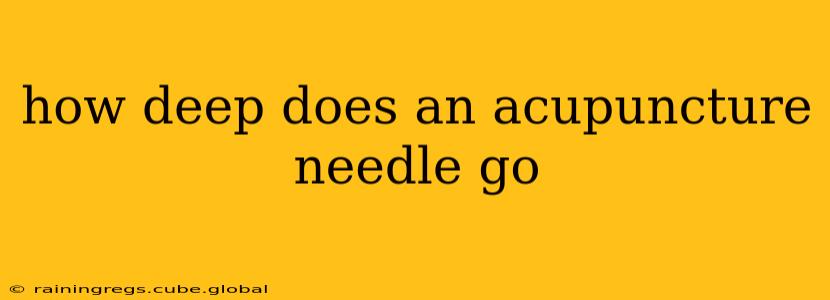Acupuncture, a cornerstone of Traditional Chinese Medicine (TCM), involves inserting thin, solid needles into specific points on the body. But how deep do these needles actually go? The answer isn't a simple number, as the insertion depth varies considerably depending on several factors. This comprehensive guide will explore the nuances of needle depth in acupuncture, addressing common questions and concerns.
What Determines Acupuncture Needle Depth?
The depth of needle insertion isn't standardized. Instead, several crucial factors influence how far a practitioner inserts the needle:
-
The specific acupuncture point: Different points on the body are associated with varying depths. Some points, located superficially on the skin, require only a shallow insertion, while others, situated deeper within muscle tissue, necessitate a deeper approach. An experienced practitioner possesses a detailed knowledge of acupuncture point locations and their associated depths.
-
The patient's individual characteristics: Factors like body type (muscle mass, fat distribution), age, and the condition being treated significantly impact needle depth. A patient with more muscle mass might require a slightly deeper insertion to reach the intended point, while an elderly patient may require a shallower insertion to avoid discomfort.
-
The practitioner's experience and judgment: A qualified and experienced acupuncturist assesses each patient individually, determining the optimal needle depth based on their unique needs and the specific treatment plan. Their expertise ensures safe and effective treatment.
-
The type of needle used: While most acupuncture needles are quite thin, there are variations in length. A practitioner selects the appropriate needle length to ensure the correct depth is achieved without unnecessarily penetrating deeper tissues.
How Deep is "Shallow" or "Deep" in Acupuncture?
While there's no universally agreed-upon measurement, "shallow" insertion generally refers to a depth of less than 1cm (approximately 0.4 inches), typically used for points on the surface of the body. Conversely, "deep" insertion might reach depths of 2-3cm (approximately 0.8-1.2 inches) or slightly more, often employed for points situated deeper within the muscle tissue. However, even these ranges are relative and depend on the factors mentioned above.
What Happens If the Needle Goes Too Deep?
While acupuncture is generally safe when performed by a qualified practitioner, inserting the needle too deep can lead to potential complications such as:
-
Pain and discomfort: Penetrating beyond the intended depth can cause pain and discomfort.
-
Bleeding: In rare cases, excessive depth can cause bleeding at the insertion site.
-
Nerve damage: Although uncommon, improper insertion could potentially damage nerves, resulting in numbness or tingling sensations.
-
Pneumothorax (collapsed lung): This extremely rare but serious complication occurs if a needle accidentally punctures the lung, typically only possible in specific areas of the chest.
Is it Painful?
The sensation during acupuncture needle insertion varies from person to person. While some individuals may experience a slight prick, others report no sensation at all. After the initial insertion, most people experience minimal discomfort or a dull ache, which is often temporary. The practitioner uses techniques to minimize any discomfort.
What are the Benefits of Acupuncture?
Acupuncture's therapeutic benefits are attributed to its impact on the body's natural energy flow (Qi). While further research is ongoing, many studies support the effectiveness of acupuncture for a range of conditions, including:
- Pain management (back pain, headaches, etc.)
- Nausea and vomiting
- Stress and anxiety
- Insomnia
- Infertility
Finding a Qualified Acupuncturist
Choosing a licensed and experienced acupuncturist is crucial for ensuring safe and effective treatment. Verify their credentials and look for practitioners who have undergone extensive training and are knowledgeable about acupuncture techniques and safety protocols. Never hesitate to ask questions about their experience and approach to needle insertion.
By understanding the factors influencing acupuncture needle depth and seeking treatment from a qualified professional, patients can experience the potential benefits of acupuncture while minimizing any potential risks. Remember, safety and proper technique are paramount in this ancient healing practice.
